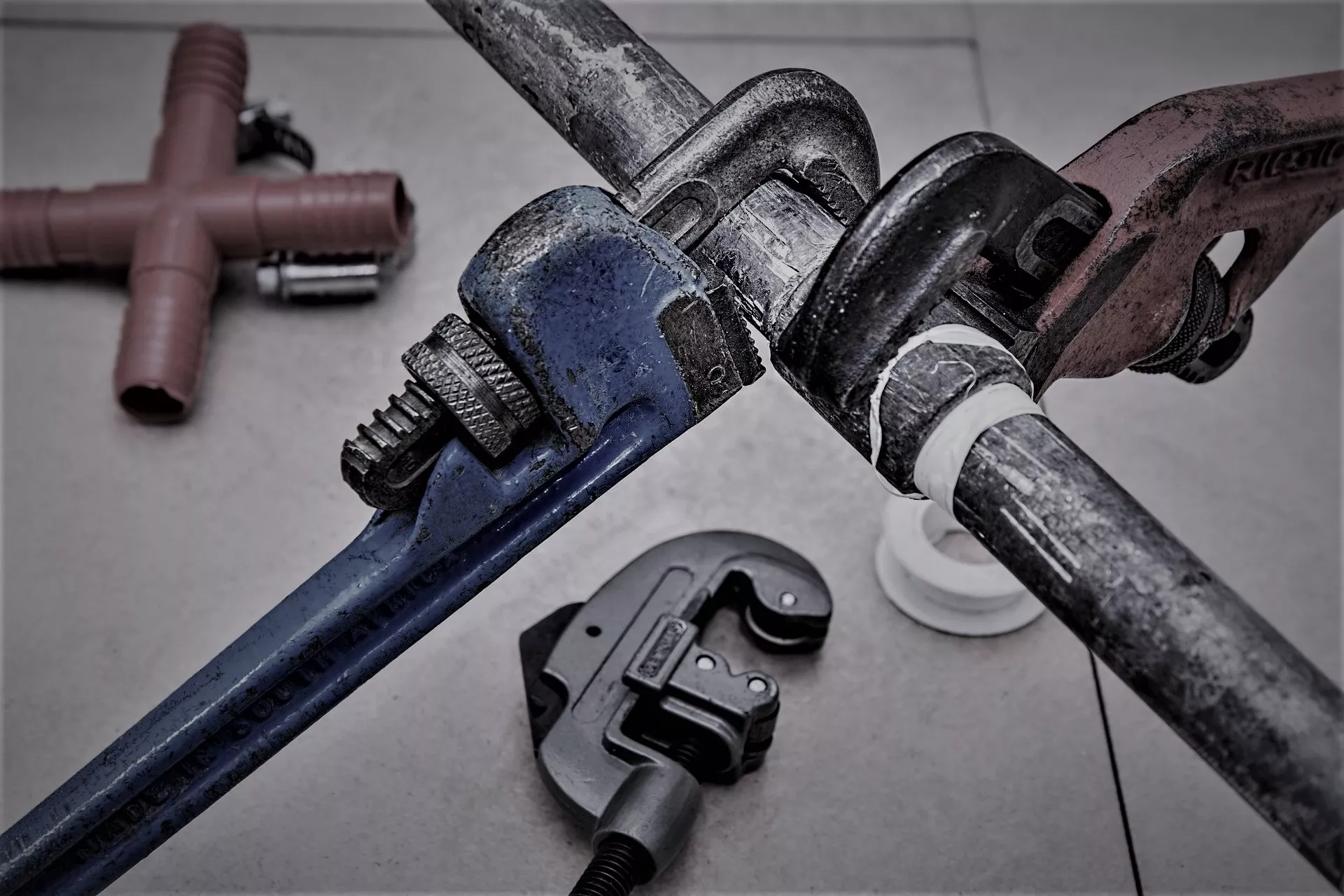Sign up for our newsletter
Explore more

6 Best Strategies for Growing a Plumbing Business
If you run a Google search for “plumbers in Denver,” you get 43 million results.
Granted, they do narrow that down to 50+ plumbers nearby (though who knows how many businesses are in that “+” 
Ten pages in, and I’m still looking at generic title tags like “plumbers in Denver” and “Denver plumbers”.
You can implement SEO all you want, but there are at least 50 other businesses in the area all vying for that top slot on a Google search page.
But wait… Around 86% of the population go straight to Google Maps (or some other map tool) to find local service-based businesses, such as plumbing companies.
Once there, they’ll pay more attention to your review counts and stars than anything else.
Who wouldn’t want to work with a business that has 5,000 positive reviews compared to 70?
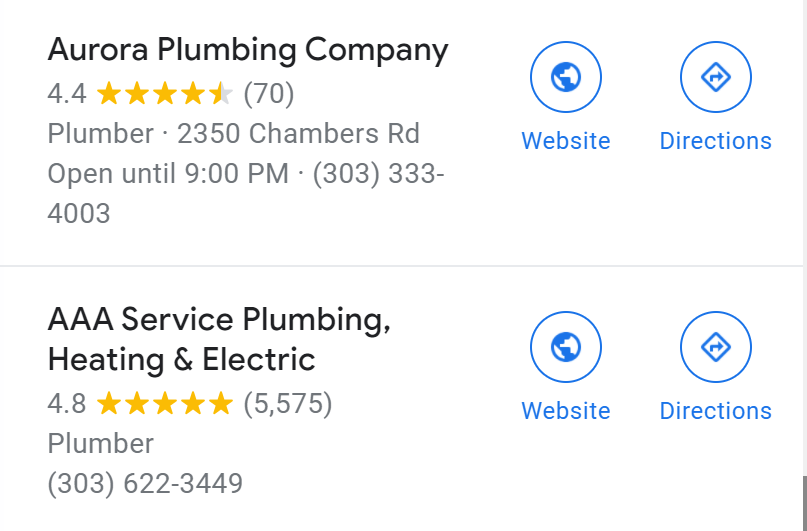
Why am I putting so much emphasis on organic search and maps?
I think Debra Mastaler, Founder and President of Alliance-Link, puts it best:
I’ll be the contrarian here and say no one looking for a plumber will stop and read funny stories, watch a video or search on lawn care sites for a plumbing source. You’re going to type in the name of your town + ‘plumber’ and check out the companies listed first with the most/positive reviews. The key to ranking companies like plumbers and electricians is knowing how Google Local/Places operates and working it.
Now, I do slightly disagree that plumbing companies can’t build some long-term reputability or gain leads through blog content or other slow working marketing strategies (like social media).
And… plumbing marketing strategies aren’t limited to simply focusing on collecting reviews and being on Google Places.
That is why I’m breaking down the exact plumbing marketing strategies that we use for our clients, including how we help them get to the very top of those 43 million results.
Want us to create a marketing strategy for your plumbing business? Learn more about our services, or reach out to us, here.
How to Market A Plumbing Business:
There are a few things that set marketing for service-based companies, such as plumbing companies, apart from most other businesses:
- Everyone NEEDS a plumber at some point (and that need is typically immediate)
- The need is very local
- There’s a heck of a lot of competition (and there really aren’t too many ways to set your business apart from the others)
You can hit those first two points by…
Listing your plumbing business in directories
This is kind of the oldest trick in the book… literally. If you don’t remember them, they were these big yellow bricks… books… that were dropped on your front stoop every month with numbers to every local business.
Back then, all that mattered was that you were listed, and you’d get business.
Today, we still have yellow pages, but they’ve taken shape into these behemoth databases of various industries.
It’s places like:
Then there are the niche business directories- the ones for specific industries. For plumbing, that’s:
Be listed in as many of these directories as possible, BUT pick a few to focus on.
These sites allow you to add vital details about your business as well as collect reviews. Now, you can sit around and hope that your customers will post a review on one of these sites…
Or, you encourage them to post reviews on these particular sites by sending them a link at the end of your service.
This may mean sending them an email to ask how it went, with a link to add a review. You may even be able to request a testimonial directly from the directory (especially if they booked your service through that directory).
It’s simple… but being discoverable and having sound social proof- you’re a legitimate business with happy customers- is one of the most vital marketing moves any business can make.
That brings me to the next marketing strategy strongly advised for any plumbing business…
Social proof
Growing a plumbing business (or any service-based business, for that matter) is about proof.
Proof that you’re reputable and are who you say you are. Proof that you are good at what you do and can compete with even the biggest dogs in the plumbing industry. And, proof that you’re the best option for the money.
There are quite a few ways to provide the customer with social proof, even across various channels.
For social media- social proof is the engagement customers have with a brand. It’s the number of times they mention your brand and interact with your content. It’s the number of likes and views. It’s the loyalty. (p.s… you can also share testimonials from review sites on your social).
For review sites- competing on a review site is about the number of reviews you have and how good those reviews are. But it’s not just about the number of stars. It’s also about how much your customers rave. Comments are compelling, so encourage them.
For your website- testimonials/ reviews are great social proof on your website as well, but they’re not the only things you can (and should) include. Here are some other options:
Show off any awards/certificates you’ve earned, even if it’s just a good standing or a license from the Better Business Bureau (BBB).
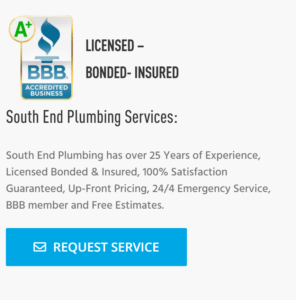
Those accolades are a way of ensuring trust with the customer. They want to know that you’re reputable. You can do this with other verifiers too, such as a HomeAdvisor vetted stamp and Google reviews:

Put your most significant accolades upfront, but don’t forget the little things, like your support for groups and community programs.
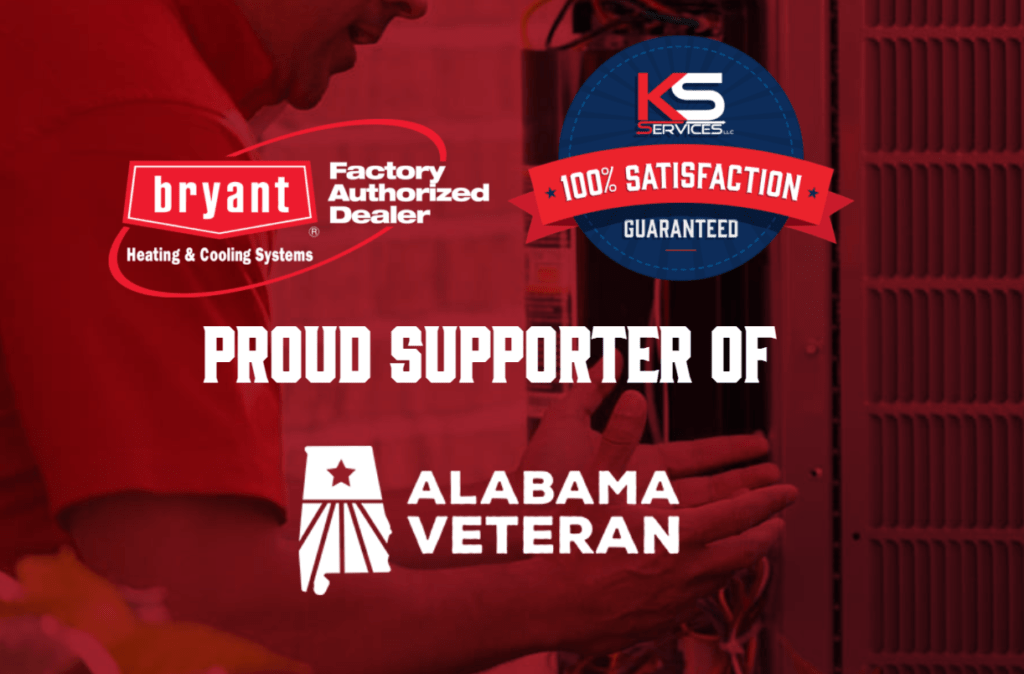
Highlight the recognizable brands you work with:

Even a simple count of the number of positive reviews you have can do wonders for generating trust between you and the customer.
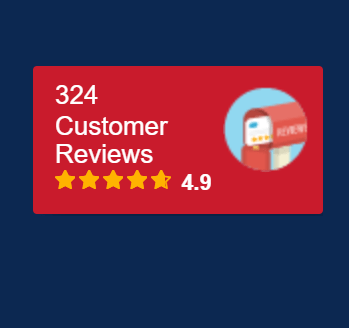
Even your long history can work as social proof. If you’ve been in business for 25 years, then you have enough to keep you running. There’s something to your business that keeps people calling. It’s just one more layer of proof that you’re reputable.

Don’t leave anything off the table. These are genuinely some of the most straightforward measures you can take to hit that point of trust. It’s one of the main things your audience needs to consider hiring you, so use everything you can.
PPC Ads
On mobile devices, PPC ads can have a conversion rate as high as 80%. This is a compelling statistic, right?
But it neglects to include just how easy it is to drain your money on PPC ads with little to no return.
The most common mistakes with PPC ads are:
- No phrase match selection, which delegates how your ad appears in a search
- No negative keywords or choosing the wrong keywords
- Improper demographic targeting
- Linking to a home page of a website instead of a landing page
- Not taking advantage of ad extensions (such as phone number, review count/ stars)
PPC ads may be easy to mess up if you’re not very familiar with them, but they’re also effortless to set up, change, and test.
You’re meant to continually test your messaging and keywords, change all the settings and optimize.
Some say it’s the only true way to create PPC ads that convert.
But I disagree.
You can start with really solid ads that convert well from the beginning- and get you ahead of your competition- by playing up trust and common problems.
If there’s one thing I’ll always suggest to clients, it’s to know the biggest and most common challenges your audience faces.
When it comes to plumbing, it’s always something like having a clogged toilet or leaky sink.

Everyone is going for those obvious keywords like “plumber in Denver”. But you can’t beat everyone for that top ad slot.
Go for the less obvious keywords. Shoot for the terms and phrases that people are searching for when they feel like they don’t need you right away.
Aim for the problems they’re trying to solve: “clogged toilet”.
Go all out and include various versions of that phrase to ensure that you’ll show up during those searches.
“Toilet clog”
“Unclog my toilet”
“How to unclog toilet”
To play up trust in plumbing PPC ads, you add trust symbols/ phrases in the meta description. Phrases like, “licensed and vetted by the BBB” or “100% satisfaction guarantee”.
You can even answer some of the most common questions plumbing customers have, such as “how much is this going to cost” or “do I have to pay it all upfront” to prequalify clicks.
It’s a matter of adding the base price to the ad, or phrases like “flat rates” and “free same-day estimates”.

There’s more to PPC ads than just picking generic terms and paying a bit of money to put them out there. Everyone’s doing that, and it’s a great way to burn a lot of money.
But if you’re a bit more methodical- optimize for lesser-used terms, include variations of keywords, trust phrases, and answer questions- you’re bound to get a great ROI.
Design your plumbing website the right way
There are a heck of a lot of web design templates out there right now, which is great because it makes it easy for anyone to build their empire- so to speak. But… It also leaves a lot of room for error.
Plumbing web design is far different from that of, say, a faucet company.
Now let me clarify. You can use any template for a website. Design it any way you want, really.
But if you want your website to convert, you need certain elements on your site.
Let’s look at a few plumbing websites with high-converting designs.
Above the fold (the top of the website):
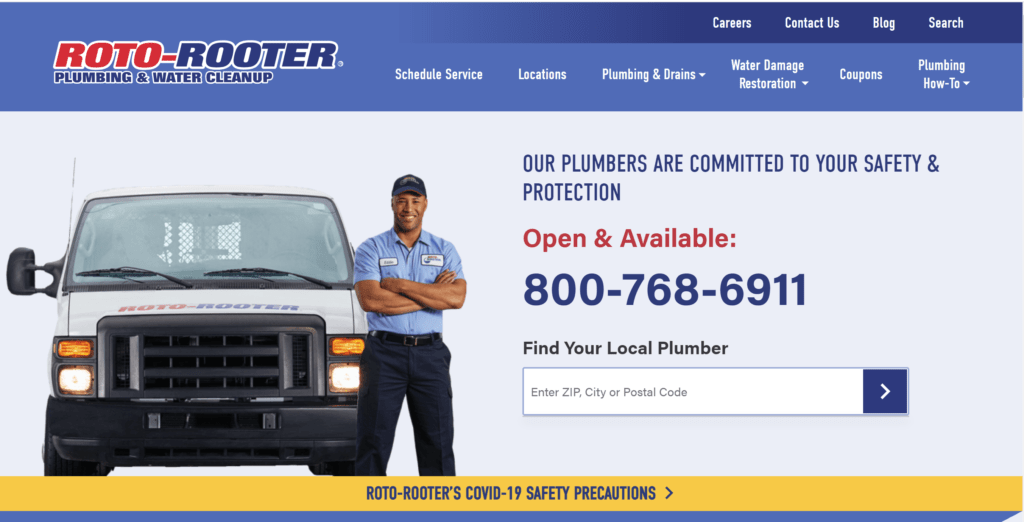
Starting from the top of the Rotorooter website, notice the headers of their navigation tabs. They’re extremely specific- “schedule service” and “coupons” stand out in particular because they’re making it easy to save money and make an appointment.
Roto-Rooter highlights this fact with the big, bold phone number and plumber location finder above the fold.
They’re also clearly providing value through their how-to tabs, which offer guides for taking care of the problem yourself as well as preventing issues from the very beginning.
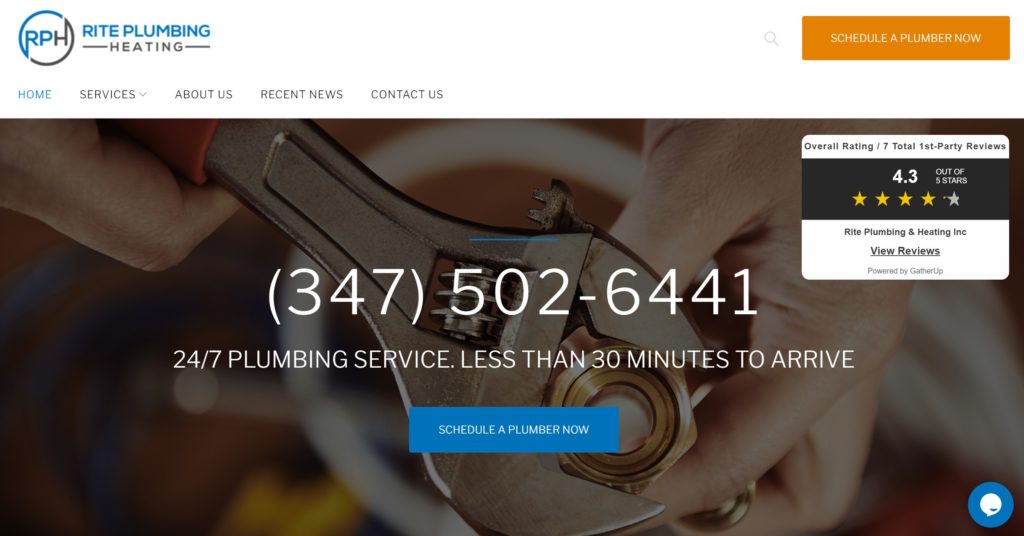
You can see that on the Rite Plumbing website as well. You can clearly see that they’re doing everything they can to make it easy for the customer to reach them. Here’s what I see:
- Their phone number, big and BOLD, front and center
- TWO calls to action buttons “schedule a plumber now” (adding that now is a great touch because it encourages immediate action).
- They also have a contact us tab in the navigation bar
- They’ve also added a live chatbot to engage them in a conversation immediately- if they have questions but can’t (or don’t want to), call.
That’s four different ways to contact them, all before you even have a chance to scroll through the rest of the page.
They’ve also added their star rating and a way to check out reviews, and it’s very noticeable.
Customers can read reviews right then and there and contact you in any manner they like.
According to Payman Torkiyan, these are the most critical elements on a plumbing website if you want the visitors to convert:
Majority of people are going to be calling a plumber when an emergency happens. So, making it easy to call or schedule a service call is the priority. 2nd – is letting the potential customer know that your company is reputable. Showing reviews, certifications, real images of your crew is important.
Below the fold:
Your site visitors see the top of the article- everything above the fold- first, so it should be compelling.
At that point, those that are already ready to hire might reach out. But there will be a portion of your audience that needs a little more convincing.
That is why the rest of your homepage should have these important sections:
- Services
- Reviews
- FAQs
Yes, just those three elements. The first part of your website is the most important. The rest is just convincing factors and some vetting information.
For instance, your visitors might have a specific issue they need to fix. Or, maybe the potential customer is a business, and they want to make sure you handle that kind of work.
A services section answers that.
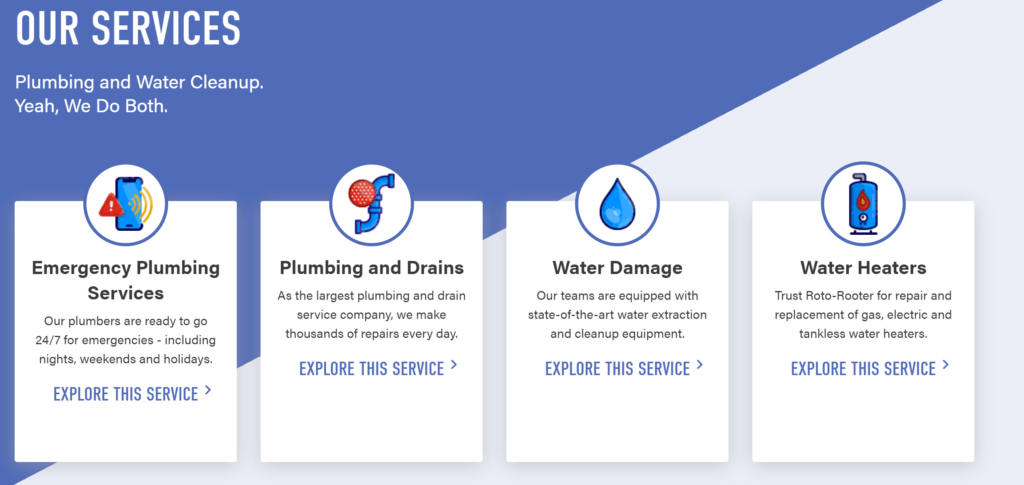
Above, you see that Roto-Rooter lays out their essential services, with the option to explore more details.
It’s a snapshot that allows visitors to immediately determine whether this plumbing service suits their needs.
Notice that it’s simple? There isn’t a lot of text, and the pictures emphasize the service… Essentially, it’s designed for scannability.
Even if the user slides through, they’ll quickly grasp what the site and the business is all about.
Rite Plumbing does something similar, except they’re focusing more on the SEO opportunities this section offers.
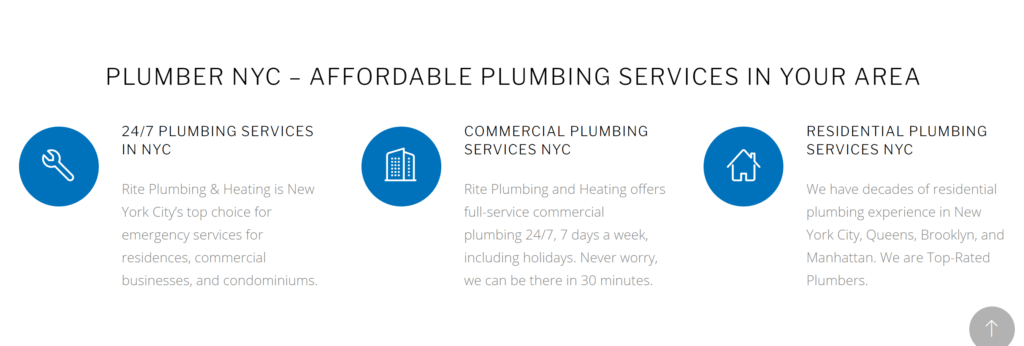
Notice the headers of these columns… they’re all keyword phrases. The descriptions for each column also capitalize on SEO, while also answering user questions on where they serve and what kind of services they provide.
South End Plumbing took a different approach.
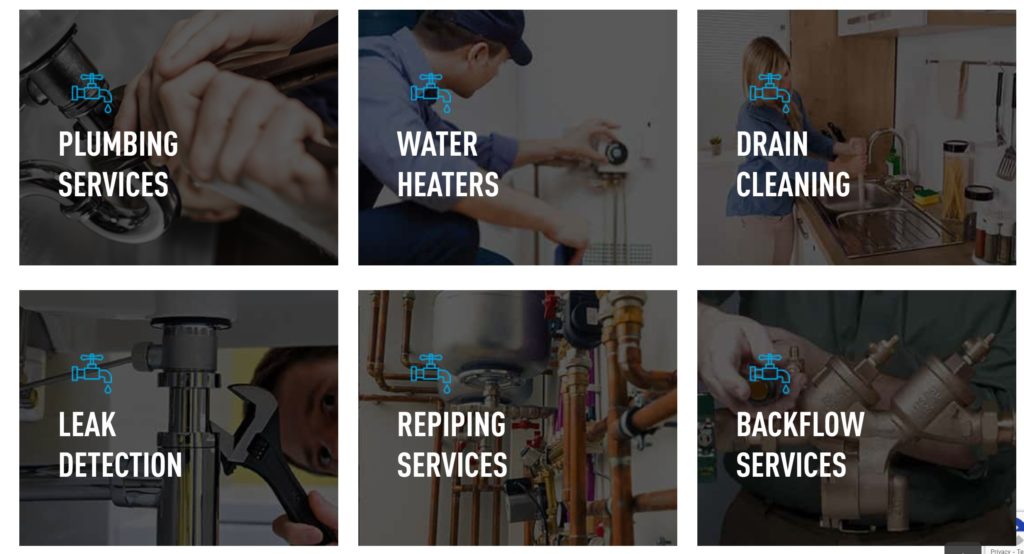
They kept it scannable. When it’s this simple, users can immediately grasp what they do and whether or not they can help with their issue.
They build on their site by expanding on those services on other pages.
Onto reviews…
We’ve already covered that reviews are everything when it comes to a service-based industry.
It’s essentially word-of-mouth marketing, just on a grander scale.
But the same principle applies. People trust other people. They trust those who have worked with businesses, hired services, and gone through the same processes.
Leverage that.
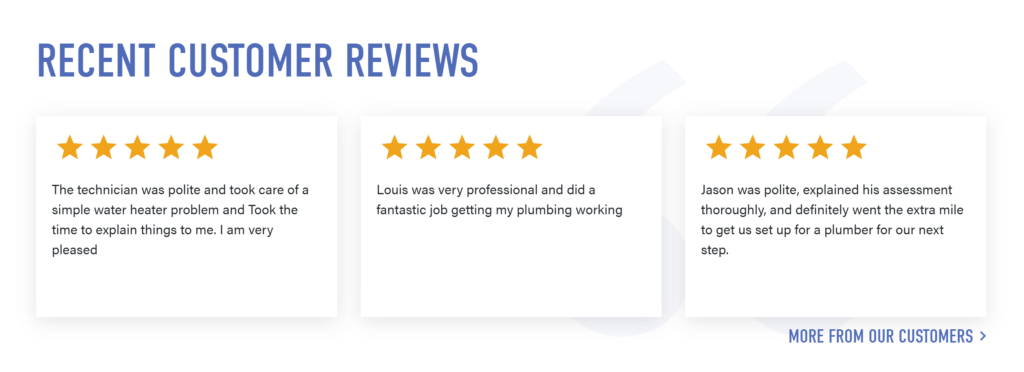
It doesn’t have to be complicated.
Some hosting platforms link with review sites to continually refresh your website with the latest reviews.
If you don’t trust that or want to highlight the most compelling reviews, just pick a few of your best (make them recent).
Add a link to allow them to look at the rest of the reviews too.

If you have a lot of reviews (hundreds or thousands), then highlight those too.
Now, as far as adding an FAQ section goes, it’s not necessary.
Most plumbing homepages are pretty short. They include the few sections mentioned above and maybe another section on the company story or the employees to add some text for SEO purposes.
But adding an FAQ section can be helpful to your audience. The most common questions plumbers hear are:
- Are you Licensed?
- Are you Insured?
- What are your Service Fees?
- What is your Typical Response Time?
- Do you Offer 24 Emergency Service?

You can answer a lot of these questions across the rest of your site.
If you’ve placed your license badges on the site, well, that answers that.
If you’ve said “we’re licensed and insured” somewhere on the page, that’s generally enough of an answer (though showing proof of that is always a great idea).
As you saw from Rite Plumbing’s services section, one of the headers mentions that they’re a 24/7 service.
As long as your website answers questions, you’re golden. But if you want to dive deeper into those answers (or help the answers stand out more), you can add an FAQ section.
Social media & forums
Oh, social media- what an original suggestion, right?
But forums…
Actually, I don’t even want you to use social media the traditional way.
Sure, sure, post once a day to share your latest blog post and company news, coupons, etc. But there’s something better than that:
Engagement.
There’s this tactic called social listening. It essentially entails finding relevant conversations across social media channels, and subtly interjecting by offering answers.
For instance, if you go onto Twitter and type in “sink leaking” into the search bar, you’ll find posts like this:

And this:

Of course, there will be some wading through profiles and unrelated posts, but adding a comment here and there, even when they’re not asking for a plumber, is an excellent method of brand awareness.
Oh, ps, there is an advanced search option to make finding related posts a little easier. Just click the three tiny dots next to the search bar on Twitter, and this window will pop up:
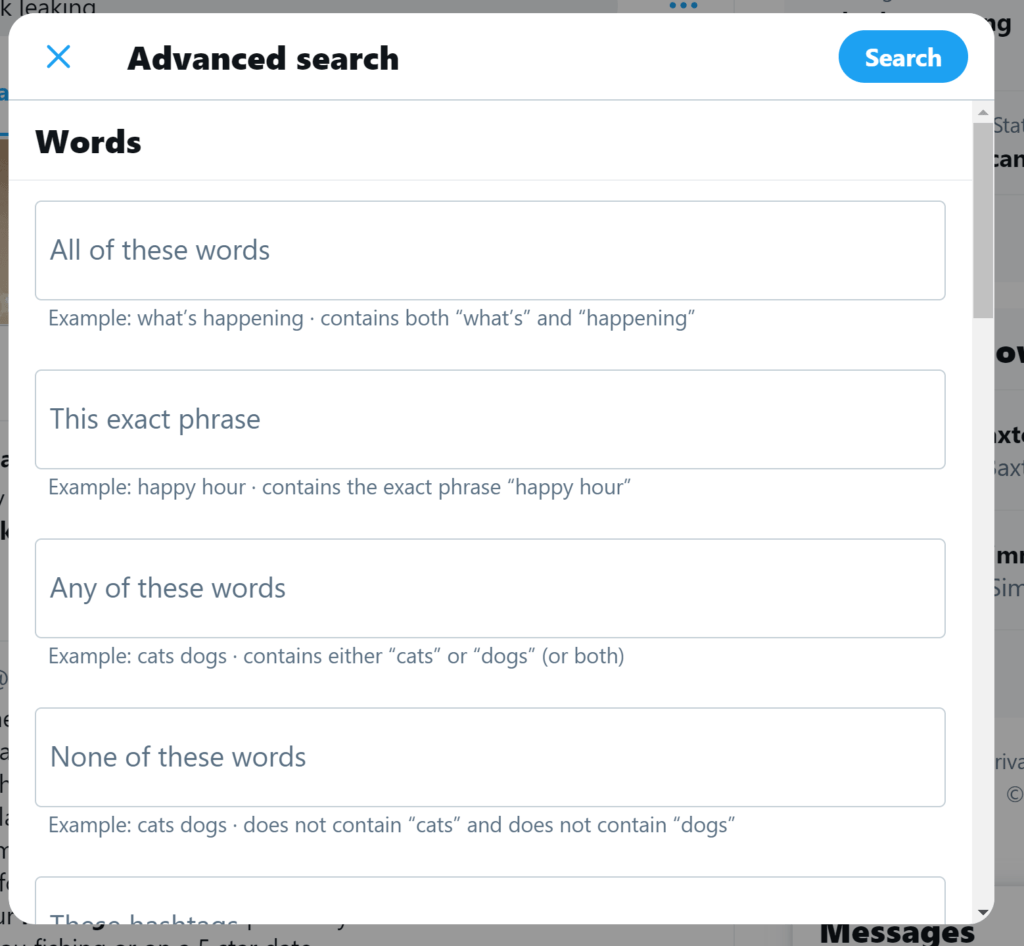
If you have a social media tool, like Hootsuite, you can create streams to follow certain words and add your comments right then and there.
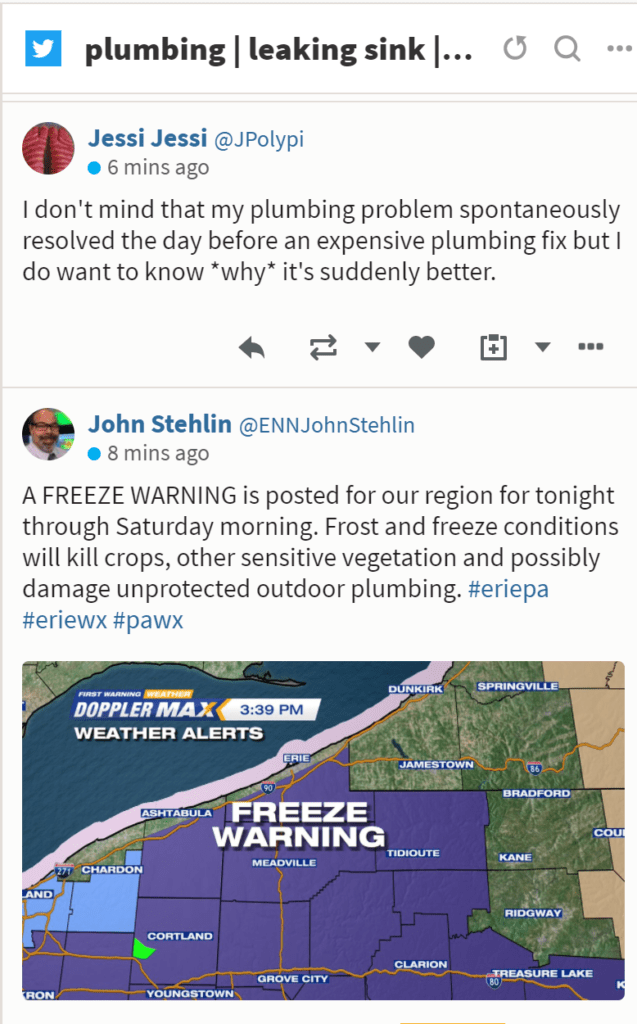
On Facebook, there are groups dedicated to different niches, interests, and problems. Join, and start commenting and answering questions.
If you think there aren’t groups about plumbing issues, think again. Here are a few groups to join:
- Plumbing Hacks and Plumbing Professional Discussions
- Ask A Plumber
- Professional Plumbing Services
- Plumbing Help
- FREE PLUMBING- ask a plumber advice
In these groups, you’ll find tons of posts like this:
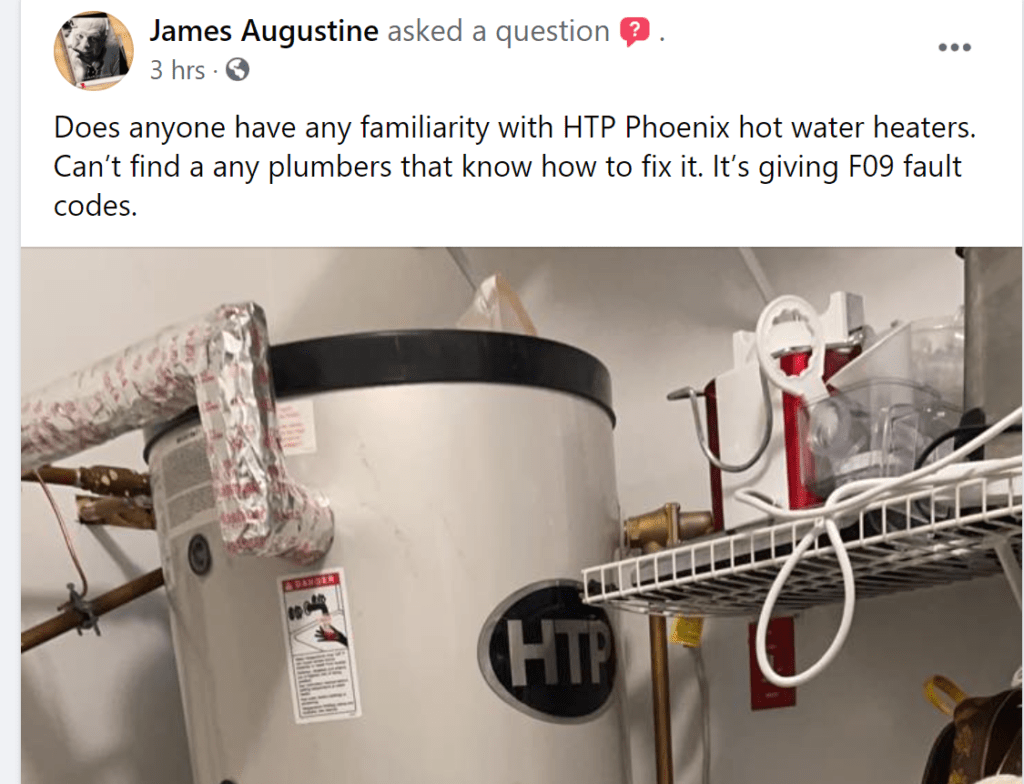
(You can also create your own group and engage in these other groups to drive people to your own group.)
Straying away from social a little, there are also tons of forums for niches like plumbing or advice on plumbing.
Take Quora, for example.
On Quora, you’ll find questions about leaky sinks and whether or not they even need a plumber.
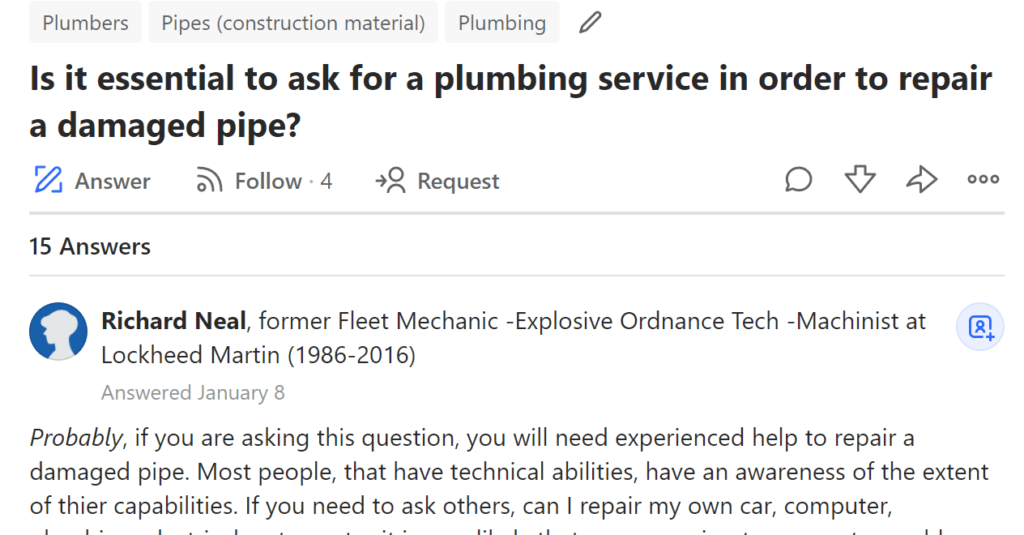
And…
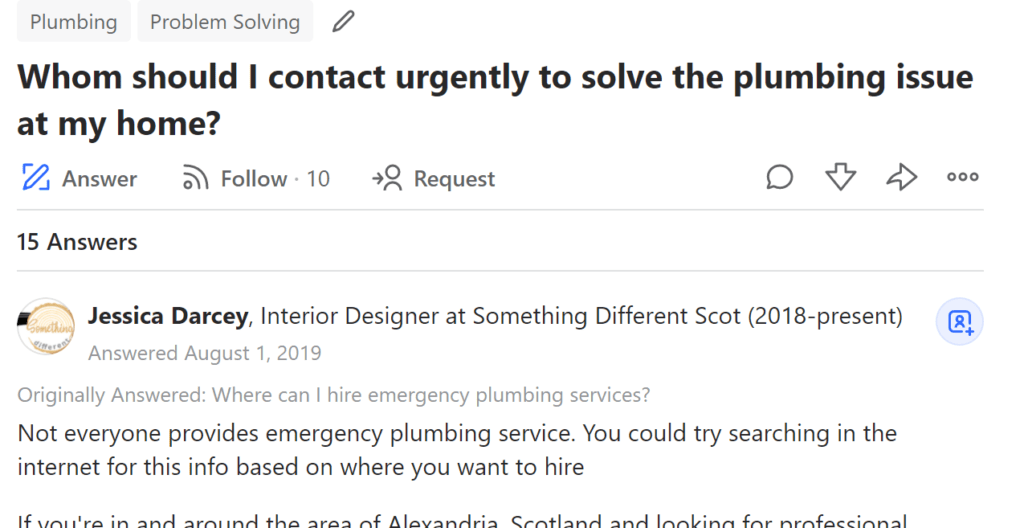
As social media goes, people connect to hundreds and thousands of others all across the country. The more you show up in their feeds, the better.
You only have so much reach when you just post to your channels. Only your followers will see what you share (unless they share the post).
But on forums, you can answer direct questions about services you offer, and those answers may be seen by hundreds or thousands MONTHLY.
I know it doesn’t seem like this would be a lead generation method for plumbers or any business, for that matter, but there is a reason more prominent brands put so much effort into becoming a household name.
It’s about recognizability.
People associate name recognition with credibility.
This applies to every business/ brand.
Creating a presence online is just a part of that.
Blogging and other valuable resources
Everyone has a blog these days, right?
Yes, blogs saturate the internet, and every day, that database only grows larger. But that shouldn’t discourage any business from blogging- even a plumbing business.
If you have the skills or the budget to produce content for your website, then you absolutely should.
There are two reasons why:
- SEO purposes
- Brand awareness
I’m going to go ahead and say that most plumbing blogs aren’t going to generate leads (at least not like blogs from other industries can).
But, just like social media and engagement in forums, blog posts expand your reach and increase recognizability.
Blogs also:
- Improve the domain authority of your website (which helps you rank higher in searches)
- Force search engines to continually check your site for new content to index (which helps you rank better)
- Make it easy for customers to find your business organically, which is generally more trustworthy in the audience’s eyes.
- Position you as an authority on all things plumbing.
Audiences have trust issues.
They’re skeptical of your reputability and credibility. They don’t know if you know what you’re doing.
Blogs establish that you do.
Also… people love free value. So, when you provide them how-to guides and tips for preventing disasters, they’re more likely to see you as a trustworthy resource that isn’t just there to scoop up the money.
But how do you blog for a plumbing company? What would you even blog about?
Don’t create content for the sake of content.
If you’re going to blog, follow this process:
- Audience research
- Create a calendar
- Write
- Distribute
Audience research for a plumbing company is as simple as taking note of your customers’ questions when they call or when you’re on the job.
If that doesn’t yield enough ideas (and it really should), then turn to social media and places like Quora.
I’ve already shown you examples of people asking questions in these places.
Those are your content ideas. Those are the questions you should answer with content.
Heck, you can even turn your answers on those forums and social media posts into blog content.
Creating a calendar is more than just spacing articles out, one per week. It’s about mixing content to capture people along all stages of the sales funnel.
It breaks down like this…
- Just found out about you/ just browsing
- Researching
- Ready to buy
You should create content to match all stages of the buyer’s journey.
Just browsing- content that primarily focuses on SEO and the search volume of those keywords. It’s generally content meant for a larger audience that isn’t asking specific questions about your service.
Researching- answer specific questions your audience has had.
Ready to buy– compare your business and costs directly to your competitors. Showcase customer cases (especially if you provide plumbing services to businesses), testimonials, and your customer service or deals.
The goal is to create various types of content that’ll snag readers at different stages of buying.
Once you’ve created content, you need to distribute it.
That’s just as simple as finding content ideas.
If you’re already engaging in forums, Facebook groups, and finding conversations in these places, then these are the same places to distribute your content.
Don’t rely on SEO to get you ranked on the front page of a Google search. There are thousands of other businesses fighting for the same spots.
Instead, build your audience, and engage with them, and provide value where they (and you) already are.
Building a plumbing marketing strategy: How to market MY plumbing company?
Work with a plumbing marketing company or do it all yourself- either way, marketing is better when it’s circular.
Notice in the blogging section that I mention other marketing strategies to create content creation/ ideation/ distribution?
Content ideation comes from your engagement on social media (and experiences with customers), and so does your distribution.
I also mention that you can write posts and responses to questions on those channels and then use those responses as a base for articles.
Repurposing content and using channels for more than one strategy keeps you on track and on-brand. It familiarizes your audience to you and keeps you aligned with them.
There are many plumbing marketing ideas out there, and most of them revolve around capturing leads at the end of the buyer journey (PPC ads, mostly).
Focus on creating a brand that people can trust. A brand that has answers and is easy to find/ reach when your customers need you.
There’s more than one marketing strategy to achieve that.
Want us to create a marketing strategy for your plumbing business? Learn more about our services, or reach out to us, here.


